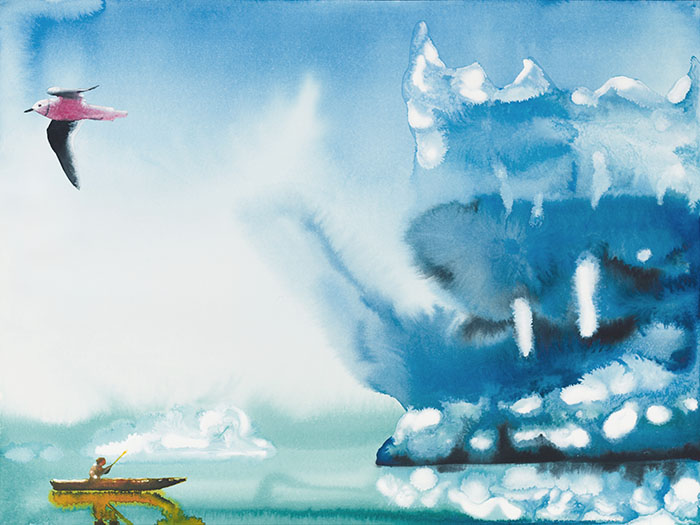Alexis Rockman: Shipwrecks
Peabody Essex Museum • Salem, MA • pem.org • Through May 31, 2021
What lies beneath? How do we balance our fear of the unknown with our desire to know, and what are the costs of knowing? Alexis Rockman: Shipwrecks, originating at Guild Hall of East Hampton, NY, and now on view at the Peabody Essex Museum, conjures these and other questions—suggesting there’s a price to pay for our human interventions, and some forces are larger than we are. The ocean and its weather have sunk and stilled ships since humans set sail upon it, and generations of artists have both romanticized and mourned such dramas. Rockman takes a different tack—narrating tragedy from the perspective of its ecological toll.
The fact that the exhibition is displayed in large part in the PEM’s East India Marine Hall is no accident: the vast hall was built originally for the display of the types of naturalist collections that Rockman has painted—spilled into the inky depths where they are poked at by real and mythical sea creatures, ghostlike in their toothy curiosity. The still-living fauna of those explorations perch atop flotsam: a monkey clinging to a still-floating barrel, a cat atop a treasure chest, exotic birds taking flight.
Rockman’s smaller scale works on paper line the walkway leading up to the hall’s main entrance. Imagery whispers upon their surfaces, into and out of abstracted forms: vivid figures emerging from the misty hues of blue sky and teal ocean, or red sky and black ocean. In Calving, for instance, a gull soars above while below, a lone traveler canoes in the opposite direction, detonating iceberg looming ahead.

Rockman’s oil paintings are something else altogether. At once representational and bristling with flourishes of painterly abstraction, the real meets the surreal in these grand-scale scenes of man tangling with a foe it will never conquer, even if that foe is damaged irreversibly. Almost dwarfed by the cavernous space, interspersed with the museum’s collection of ship figureheads, the ten paintings line one long wall of the large hall, in some cases arranged salon style, so that one must look upwards to view them. Perhaps this is meant to conjure the feeling of being swallowed up by the sea and sky.
One could view Rockman’s smaller watercolor-and-acrylic paintings as studies for these larger scene paintings, taking the emotional resonance of historical moments and realizing their narratives on the larger surfaces of his oil paintings. For instance, in Lifeboat HMS Terror, (2020, watercolor and acrylic on paper, 18 x 24″), a polar bear peeks its head over the side of an empty lifeboat, light-dappled water seemingly rising and falling all around, suggested by Rockman’s dynamic brushwork. Alternatively, in The Lifeboat of the HMS Erebus (2019, oil on wood, 40 x 48″), as one polar bear peers over the rail, another is now almost entirely inside the boat—this one looking directly at us, a nod to the European painting trope of a figure gazing back at the viewer. Both paintings reference Sir John Franklin’s failed 1845 arctic expedition and the loss that followed, as no one is believed to have survived.

Many of the PEM’s own marine paintings from its permanent collection speak to storms at sea and sinking ships, cannon-blasted hulls and fiery debris beneath roiling skies. Human tragedy might be the norm when it comes to the shipwreck genre of painting, yet perhaps the greater tragedy is what humans have wrought against those without a say—namely, animals and nature. One can imagine the polar bear climbing aboard the boat as proxy for the icebergs that are slowly melting into the sea, spelling the doom of its species.
In Horse Latitude, a horse swims away from the ship from which it has been discarded, the boat bobbing motionless beneath a swirl of a sky meant to depict the doldrums. The ship lightened its burden by sacrificing the horse. One can’t view such an image without horror and grief, imagining the horse’s confusion and suffering. Rockman conjures an entire genre of tragedy narratives and yet his paintings take a sidelong glance, perhaps the most important perspective of all, and one that has been missing for so long.
—Julianna Thibodeaux
